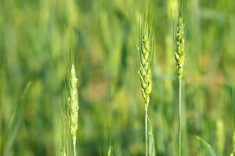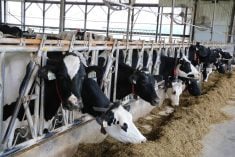Lake Winnipeg’s nutrient load and the resulting algal blooms have been a known problem and the subject of finger-pointing for years. Addressing the problem has been an equally lengthy debate.
Now the province has established hard numbers toward that goal.
On Aug. 27, Manitoba Environment and Climate Change Minister Tracy Schmidt announced Manitoba’s first formal nutrient reduction targets under the province’s Water Protection Act.
Read Also

Finally getting paid for sustainable farming?
Alberta project says they might have a line on a workable ecosystem credit model to reward farmers for sustainability, and Manitoba might be next
Why it matters: Agriculture is often painted as part of the problem when it comes to excess nutrients in Lake Winnipeg, but that is strongly contested by farmers and farm businesses.
The Nutrient Targets Regulation will establish a measurable benchmark to guide and assess progress in reducing nutrient levels, according to the province.
“This a major step forward in water quality protection for Manitobans … Establishing nutrient targets for our cherished rivers and lakes is essential in protecting those waterways for generations to come,” Schmidt said in a press release.
The regulation sets out nutrient concentration targets for sections of the lake itself, as well as loading targets for tributaries feeding into Lake Winnipeg.
For the lake’s north and south basins, as well as the narrows of Lake Winnipeg, the target for total phosphorus concentration is 0.05 milligrams/litre (mg/l). The target for total nitrogen concentration is 0.75 mg/l.
For tributaries, the province would like to see no more than 60 tonnes a year of phosphorus and 4,550 tonnes a year of nitrogen added to the lake from the Dauphin River, as measured between Anama Bay and Gypsumville.
The Saskatchewan River at Grand Rapids has targets of 340 tonnes a year for phosphorus and 8,960 tonnes a year for nitrogen. The Winnipeg River at Pine Falls is targeted to have total phosphorus loading of 1,050 tonnes a year and total nitrogen loading of 19,450 tonnes a year.
The Red River is given more grace for phosphorus under the plan. The province wants to see no more than 2,800 tonnes of phosphorus coming in at Selkirk each year, and no more than 19,050 tonnes of nitrogen.
“Establishing and implementing nutrient targets will help Manitoba’s collective water quality efforts by guiding future nutrient reduction activities and best management practices, identifying priorities and helping track progress and outcomes over time,” Schmidt said.
Agriculture weighs in
The province’s farm groups say they’re ready to chip in on the effort.
“We support widespread adoption of 4R Nutrient Stewardship … principles among farmers across the province,” said Manitoba Crop Alliance chief executive officer Pam de Rocquigny via e-mail, referring to the philosophy that fertilizer should be from the right source, applied at the right rate, at the right time and in the right place.
The often higher-tech 4R strategy is pitched as a win-win between farmers and the environment, keeping more nutrients in the field rather than wasted through runoff.
Nutrient management is a major source of research dollars among Canada’s academic institutions and commodity groups. At the Manitoba Crop Alliance, funded research priorities include updated fertility recommendations for spring wheat and corn, which support 4R and are designed to minimize risk of nutrient loss into the environment, de Rocquigny said.
The Manitoba Pork Council said its industry is also committed. Chair Rick Préjet said the sector wants to be part of the solution in protecting the environment while producing more food for Canadians and people worldwide. Having reliable data about nutrient levels in water will be key, he added.
“Farmers, including those in Manitoba’s hog sector, are taking significant steps to help address today’s environmental challenges, including the protection of our lakes and waterways across the province.”
Pork council general manager Cam Dahl said he hopes Manitobans will take note of steps his industry has already taken to protect waterways.
“In the last 50 years, there’s (been) significant strides taken to not just ensure that manure doesn’t run off into our lakes and rivers, but really to ensure that it’s utilized to its maximum effectiveness as a fertilizer,” he said. “The industry (of) agriculture has come a long, long way.”
He also pointed to the rise of soil testing, which informs nutrient management plans and ensures only needed fertilizer is applied.
Nutrient content is measured as the product is being applied, Dahl said. Producers make use of GPS and laser technology, among other techniques, to manage manure resources and nutrients.
“There have been really significant strides taken … both to ensure we’re protecting our environment as well as to ensure that we’re making the best use of this natural resource.”
If the province’s strategy is to work, however, Dahl said nutrient measurements must be rock solid. Decisions must be science-based and are only as good as the data on which they’re based.
“We need to stop pointing fingers at each other and to sit down with all the stakeholders around the lake and across the province and really come to a path forward that helps ensure that we protect that resource, and that that isn’t about pointing fingers,” Dahl said. “It’s about having the science and having the data to make the right decisions that are going to have a meaningful impact.”
A growing problem
Monitoring in recent decades has shown rising levels of nitrogen and phosphorus in Lake Winnipeg and the Red, Winnipeg, Saskatchewan and Dauphin rivers. Resulting algal blooms can be toxic and have serious repercussions for the economy, public health and the environment, said Schmidt.
Richard Grosshans, a bio-remediation lead with the International Institute for Sustainable Development (IISD) water program, believes the province’s targets are a good step.
“These are very aggressive targets being suggested, compared to current average concentrations and loading rates, and we look forward to working alongside municipalities, communities and watershed districts on solutions to meet those targets,” he said.
More water quality monitoring and data collection to help identify problem areas, along with greater efforts to reduce loading, are logical next steps, Grosshans added.
“With relevant targets from the province of Manitoba and regular monitoring, this announcement could help lessen the amount of algal blooms seen on our lakes and ponds.”
The targets are most aggressive on phosphorus, Grosshans noted. The IISD’s research has pinned phosphorus as the primary ingredient for algal blooms. Targets for nitrogen are less ambitious.
They’re also achievable, he argued, although he cautioned that the ability to meet them will run into climate and weather-related challenges.
“We get one wet season and the loading rates could spike to double, so that’ll be the challenge, to try to keep it to that target level.”
Investment in natural infrastructure such as wetlands and water retention projects should also be part of the equation, he said.
Common ground
Agriculture and the City of Winnipeg’s continued sewer infrastructure woes are commonly blamed for nutrient loading in Lake Winnipeg. Grosshans doesn’t find the blame game helpful.
“Everyone is part of the problem,” he said. “Everyone is part of the solution, so everyone needs to get on board.”
















